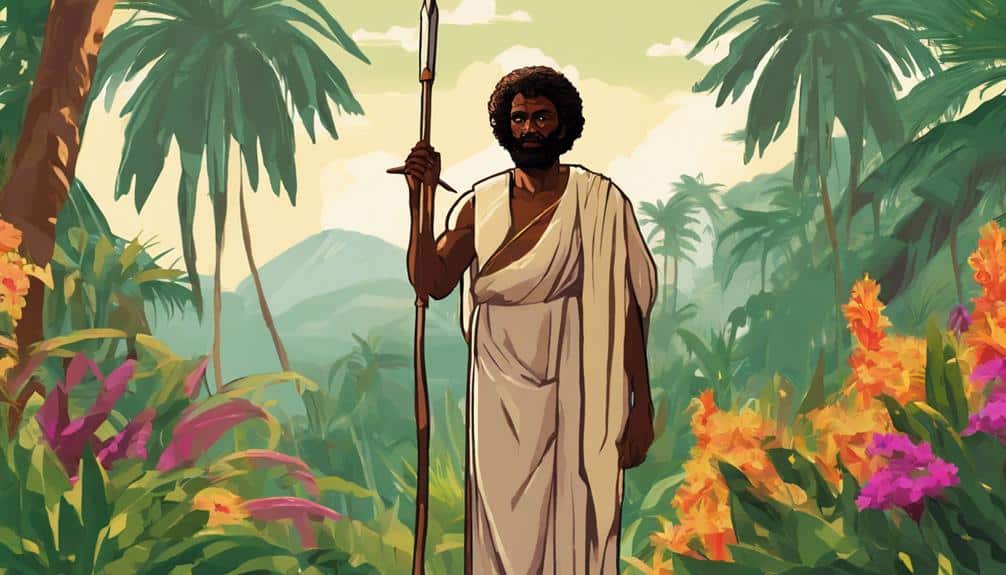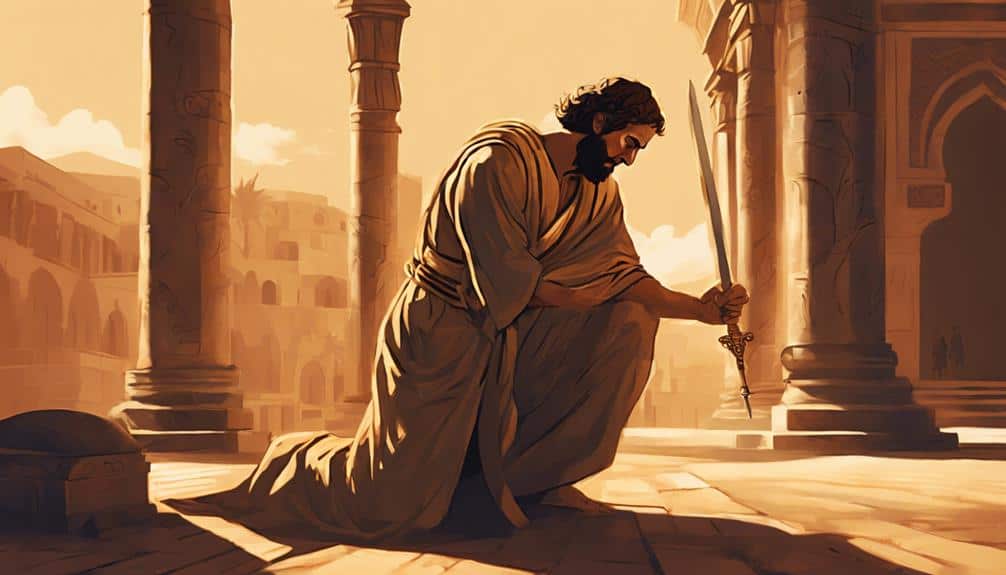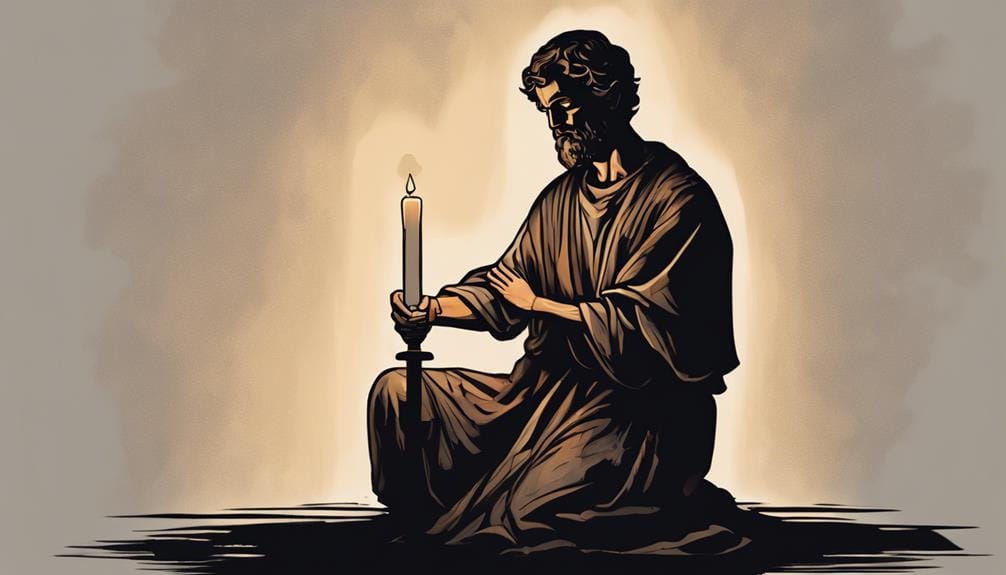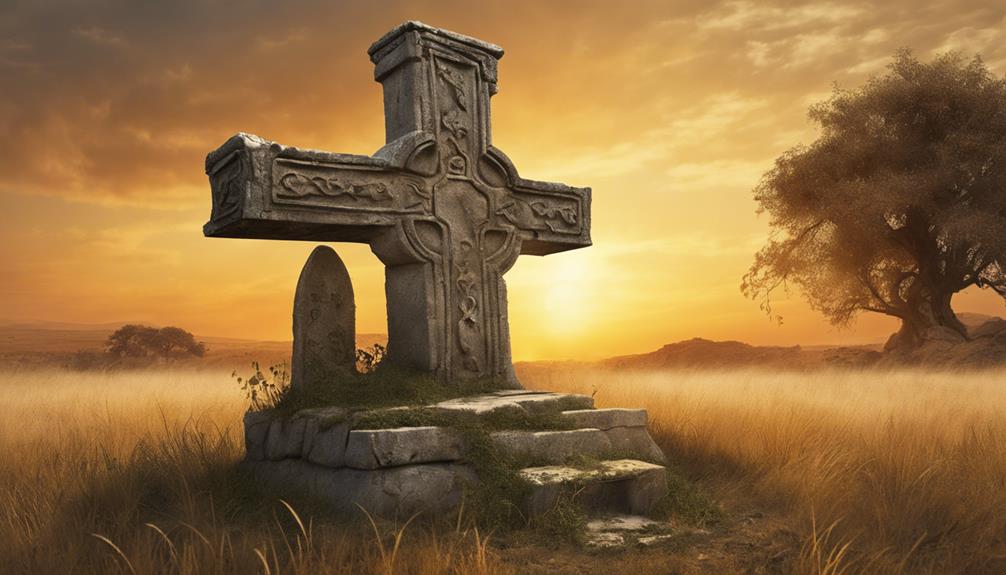You're exploring the life of Matthew the Apostle, but the circumstances of his death remain unclear. Three prevailing theories emerge from traditional narratives and apocryphal traditions. One theory suggests martyrdom in Ethiopia, where he was killed by a sword. Another proposes a natural death in Judea, contradicting the martyrdom accounts. A third theory places his martyrdom in Persia. While ancient sources agree on Matthew's martyrdom, the lack of historical evidence fuels ongoing debates among scholars. As you explore these theories, you'll uncover more about Matthew's life, ministry, and the complexities surrounding his final days.
Key Takeaways
• Matthew's death circumstances are uncertain, with traditional narratives and apocryphal traditions offering varying theories.
• Martyrdom theories suggest Matthew was killed by a sword in Ethiopia or Persia, but lack strong historical evidence.
• A natural death theory proposes Matthew died in Judea, contradicting martyrdom accounts and sparking scholarly debate.
• Despite contradictory theories, ancient sources uniformly attest to Matthew's martyrdom, emphasizing his dedication to Jesus' teachings.
• The uncertainty surrounding Matthew's death highlights the complexity of early Christian traditions and the ambiguity in historical accounts.
Theories of Matthew's Death
When examining the accounts of Matthew's demise, you'll find that traditional narratives and apocryphal traditions alike offer varying theories on the circumstances surrounding the apostle's death.
The exact circumstances of Matthew's death remain uncertain in historical records, leaving room for diverse interpretations. Traditional accounts suggest Matthew was martyred in Ethiopia, while apocryphal traditions also mention Matthew being killed by a sword. However, some sources claim Matthew died a natural death in Ethiopia, contradicting the martyrdom narrative.
Conflicting narratives exist regarding the details of Matthew's martyrdom, and the uncertainty surrounding his death has led to the emergence of multiple theories. As you explore the accounts of Matthew's death, you'll encounter a complex network of theories, each offering a unique perspective on the apostle's final days.
It's crucial to analyze the diverse narratives and evaluate the evidence to gain a thorough understanding of Matthew's death.
Martyrdom in Ethiopia Theory

According to traditional accounts, you're led to believe that Matthew's apostolic journey culminated in martyrdom in Ethiopia, a theory supported by apocryphal traditions attributing his death to a brutal killing in the region.
This theory suggests that Matthew died as a martyr in Ethiopia, a notion that has been passed down through the centuries. Some sources even claim that the apostle was slain with a halberd while preaching in the region.
However, it's important to note that this theory lacks strong historical evidence and is based on traditional accounts. Despite this, the martyrdom in Ethiopia theory remains one of the most enduring narratives about Matthew's death.
As you explore further into the apostle's life, you'll encounter conflicting narratives about his demise. While the martyrdom in Ethiopia theory is intriguing, it's vital to approach it with a critical eye, acknowledging both its limitations and the lack of concrete evidence.
Natural Death in Judea Theory

As you delve into the Natural Death in Judea Theory, you'll find that it proposes a starkly different account of Matthew's demise. According to this theory, Matthew lived out his life in Judea, eventually passing away in old age, free from the turmoil of persecution.
You'll need to ponder the implications of this theory, which suggests that Matthew's life ended quietly, without the drama of martyrdom.
Life in Judea
You may be surprised to learn that one theory suggests Matthew the Apostle died a peaceful, natural death in Judea, contradicting accounts of his martyrdom. This perspective proposes that Matthew lived out his days in Judea after his ministry, passing away without facing persecution or violence. This theory diverges from traditional accounts of Matthew's death, which often describe his martyrdom in vivid detail.
As you explore the life of Matthew in Judea, you'll find that this theory raises intriguing questions about the apostle's later years. Did Matthew continue to spread the teachings of Jesus Christ in Judea, or did he live a quieter life, removed from the spotlight of his earlier ministry?
The New Scripture provides limited information about Matthew's life beyond his time as a tax collector and a disciple of Jesus. However, examining this theory encourages you to think critically about the apostle's life and legacy. Scholars continue to debate the validity of the natural death theory, but it remains an fascinating perspective on Matthew's life in Judea.
Death in Old Age
As you explore the life of Matthew the Apostle, you may find yourself pondering the circumstances of his demise. One prevailing theory suggests that Matthew the Apostle died of natural causes in Judea, a scenario that starkly contrasts with the vivid accounts of his martyrdom.
This theory proposes that Matthew lived to an old age, eventually passing away peacefully. This narrative diverges greatly from the often-graphic tales of his violent martyrdom, instead painting a picture of a serene and natural death.
While this theory may seem plausible, it's important to acknowledge the lack of historical consensus and definitive evidence supporting it. Scholars continue to debate the validity of this theory due to the limited historical records available.
Despite this, the natural death theory remains an intriguing possibility, offering a unique perspective on Matthew's life and final days. As you consider the various accounts of Matthew's death, it's crucial to approach each theory with a critical and nuanced perspective, weighing the available evidence and acknowledging the uncertainties that surround this pivotal figure in Christian history.
Death by Sword in Persia

As you explore the circumstances surrounding Matthew's death, you'll discover that one theory suggests he met his end by the sword in Persia.
This martyrdom by the sword is often linked to the Persian Empire's persecution of early Christians.
You'll investigate the details of this theory, examining the historical context that led to Matthew's alleged violent demise.
Persian Empire Persecution
According to historical records, Matthew the Apostle's missionary endeavors in Persia may have ultimately led to his execution by the sword during a period of intense persecution by the Persian Empire. You're likely to find that the Persian Empire's opposition to Christianity played a significant role in Matthew's fate.
As you investigate the historical context, you'll discover that Persia was a region known for its conflicts and religious tensions, making it a hostile environment for early Christian missionaries like Matthew.
The Persian Empire's persecution of Christians was a widespread phenomenon, and Matthew's missionary activities would have been seen as a threat to the empire's religious and political authority. It's no wonder that historical sources point to Matthew's potential martyrdom in Persia as a result of his missionary work.
The theory of Matthew's death by the sword in Persia aligns with the broader context of early Christian persecutions in the region. By exploring the Persian Empire's persecution of Christians, you'll gain a deeper understanding of the circumstances surrounding Matthew's tragic demise.
Martyrdom by the Sword
Matthew's execution by the sword in Persia, a brutal method of martyrdom, underscores the violent nature of the persecution faced by early Christians. You may explore why this method was chosen, but it's crucial to grasp the context in which Matthew lived. As an apostle, Matthew was a key figure in spreading Christianity, and his preaching in Persia posed a threat to the established powers. Martyrdom by the sword, a common practice in ancient Persia, was a brutal way to silence him.
The sword, now a symbol in Christian art, represents Matthew's ultimate sacrifice. It's a powerful reminder of the sacrifices made by early Christians who dared to challenge the status quo. You can almost envision the fear and uncertainty that gripped the early Christian community as they faced persecution. Yet, despite the brutal nature of Matthew's death, his legacy lived on, inspiring generations to come.
As you explore further into the theories surrounding Matthew's death, you'll begin to appreciate the significance of martyrdom by the sword in the context of Christian history.
Historical Accounts of Matthew

Among the earliest Christian writings, various historical accounts of Matthew's life and death have been recorded, yielding conflicting narratives that continue to spark debate.
You'll find that the Gospel of Matthew, attributed to the Apostle himself, provides valuable insights into his life and ministry. However, when it comes to his death, the accounts diverge markedly. Some traditions suggest Matthew died a martyr, while others propose that he passed away due to natural causes.
Apocryphal sources claim that Matthew was martyred in Ethiopia, but the accuracy of these accounts is disputed. Early church fathers, such as Origen and Eusebius, recorded different forms of Matthew's martyrdom, further adding to the uncertainty surrounding his death.
Additionally, some sources attribute Matthew's death to his preaching in various countries, complicating the understanding of his fate. The lack of consensus on Matthew's death highlights the challenge of determining historical accuracy in early Christian narratives.
Early Christian Traditions

As you explore the early Christian traditions surrounding Matthew's death, you'll find that ancient Christian writings and the testimonies of early Church Fathers provide valuable insights into his martyrdom.
These sources offer a glimpse into the beliefs and practices of the early Christian community, which revered Matthew as a faithful apostle who gave his life for the gospel.
Ancient Christian Writings
As you explore the history of Matthew the Apostle's demise, early Christian writings, including apocryphal traditions, uniformly attest to his martyrdom, with a significant number of accounts pinpointing Ethiopia as the location of his ultimate sacrifice. These ancient sources emphasize Matthew's dedication to spreading the teachings of Jesus, even in the face of persecution.
You'll find that some accounts indicate Matthew faced death for his Christian beliefs, although the exact circumstances of his demise remain uncertain due to the diversity of accounts in early Christian literature.
Despite the varying narratives, Matthew's martyrdom is a significant aspect of his legacy in Christian tradition, illustrating his commitment to his faith. As you peruse these early Christian writings, you'll discover a consistent thread – Matthew's unwavering devotion to his beliefs, even in the face of adversity.
His story serves as a proof to the power of faith and conviction, inspiring generations of Christians to come.
Early Church Fathers
What insights do the writings of Early Church Fathers like Origen and Eusebius offer about the martyrdom of Matthew the Apostle? These early Christian leaders provide valuable accounts of Matthew's death, although they differ in details.
You'll notice that Origen and Eusebius, among other Early Church Fathers, mention various methods of Matthew's execution, including beheading, stoning, or being killed with a halberd. The locations and circumstances of his martyrdom also vary across these accounts.
Despite these discrepancies, the Early Church Fathers emphasize Matthew's unwavering dedication to the faith and his ultimate sacrifice. By exploring their writings, you'll gain a deeper understanding of the significance of Matthew's martyrdom in the early Christian narrative.
The contributions of these Early Church Fathers have shaped the collective understanding of Matthew's fate, even if the specifics remain unclear. As you investigate their writings, you'll appreciate the richness and complexity of early Christian traditions surrounding Matthew's death.
Matthew's Ministry and Death

While the New Testament provides little information about Matthew's ministry and death, tradition and apocryphal sources offer valuable insights into his life and martyrdom. As you explore the life of Matthew, you'll discover that he witnessed Jesus' crucifixion and ascension, continuing his teachings afterward.
Traditionally, Matthew is attributed as the author of the Gospel of Matthew, which provides a unique perspective on Jesus' life and ministry.
Here are some key aspects of Matthew's ministry and death:
- Widespread Ministry: Traditions suggest Matthew's ministry spanned from Syria to Ethiopia, spreading Jesus' teachings to a diverse range of audiences.
- Author of the Gospel of Matthew: As the attributed author, Matthew's Gospel provides a unique perspective on Jesus' life and ministry.
- Martyrdom in Ethiopia: Apocryphal traditions propose Matthew died in Ethiopia as a martyr, although the details of his death vary.
- Continuing Jesus' Teachings: After Jesus' ascension, Matthew continued to spread his teachings, ensuring the message of Jesus lived on.
As you investigate Matthew's life, you'll uncover a complex and multifaceted individual who played a significant role in shaping the early Christian church.
Lack of Definitive Evidence

Despite the wealth of information available about Matthew's ministry, the circumstances surrounding his death remain shrouded in mystery, with the New Scripture providing little concrete evidence about his final days. You're left with more questions than answers, wondering how Matthews death unfolded.
The lack of definitive evidence is striking, especially considering the significance of Matthew's role in the early Christian church.
As you explore further, you'll find that various accounts and traditions propose different theories about Matthew's demise. Some sources suggest he died as a martyr, while others indicate a natural death. The apocryphal writings and early church fathers offer conflicting details on Matthew's martyrdom, further muddying the waters.
This uncertainty surrounding Matthew's death highlights the complexity of early Christian traditions, where fact and fiction often blurred. You're forced to confront the ambiguity, acknowledging that the truth about Matthew's death may forever remain elusive.
Traditional Accounts of Martyrdom

Traditional accounts of Matthew's demise converge on a narrative of martyrdom, placing his death in Ethiopia, although the specifics of this event remain murky and open to interpretation. You might wonder what led to this conclusion.
Here are some key points to take into account:
- Apocryphal writings attribute Matthew's martyrdom to his preaching in different countries.
- Roman persecution of Christians likely influenced the emphasis on martyrdom in accounts of Matthew's death.
- Conflicting reports exist regarding the details and location of Matthew's martyrdom.
- Uncertainty surrounds the accuracy of martyrdom narratives surrounding Matthew.
As you explore the traditional accounts, you'll notice that Matthew died, but the circumstances surrounding his death are shrouded in mystery.
The emphasis on martyrdom might stem from the Roman persecution of Christians during that era. Despite the uncertainty, one thing is clear: traditional accounts all point to a narrative of martyrdom, with Ethiopia being the commonly cited location of his demise.
The Apostle's Final Days

As you investigate the final days of Apostle Matthew's life, the uncertainty surrounding his death becomes increasingly apparent, with conflicting reports and theories obscuring the truth. You'll find various accounts suggesting Matthew preached in different countries before his death, leaving a trail of mystery. Apocryphal writings attribute martyrdom to Matthew in Ethiopia, but details are disputed, making it challenging to separate fact from legend.
When you probe deeper, you'll realize that Matthew's Gospel, a cornerstone of Christian scripture, doesn't provide insight into his final days. The lack of consensus on Matthew's death highlights the complexity of reconstructing historical events. Despite the uncertainty, his legacy lives on, celebrated in feast days by both the Latin and Greek Churches.
In the pursuit of understanding Matthew's final days, you'll encounter a maze of theories and contradictions. It's crucial to approach these accounts with a critical eye, recognizing the blurred lines between fact and legend.
Unanswered Questions Remain

You're left pondering the lingering questions surrounding Matthew's fate, with the exact circumstances of his death remaining an enigma. As you explore further into the mystery, you begin to realize that the uncertainty surrounding his demise is only matched by the conflicting accounts of his life's work.
The Gospel of Matthew, a tribute to his legacy, stands as a beacon of faith, yet the details of his final days remain shrouded in mystery.
Several unanswered questions continue to plague historians and scholars alike:
- Did Matthew die a martyr or of natural causes?
- Where did he preach and minister during his lifetime?
- What role did apocryphal writings play in shaping his legacy?
- How did the Latin and Greek Churches come to honor his feast day despite the unclear circumstances of his death?
The more you learn, the more you're reminded that the Apostle's life and death are still veiled in uncertainty. The search for answers only leads to more questions, leaving you to ponder the enigmatic fate of Matthew the Apostle.
Frequently Asked Questions
How Did the Disciple Matthew Die?
As you explore the life of Matthew, you're likely wondering how the disciple met his end. Unfortunately, the circumstances of his death remain shrouded in mystery.
Theories abound, with some accounts suggesting a peaceful demise, while others propose a martyr's fate. You'll find conflicting reports of his final days, with some linking his death to Ethiopia.
One thing is certain: the lack of concrete evidence leaves you to ponder the enigma surrounding Matthew's passing.
What Are Three Facts About Matthew in the Bible?
As you explore the Bible, you'll discover three essential facts about Matthew.
To begin with, Matthew, also known as Levi, was a tax collector before becoming a disciple of Jesus.
Additionally, he's traditionally considered the author of the Gospel of Matthew, one of the four canonical gospels.
Lastly, Matthew's profession as a tax collector made him unpopular among Jews, highlighting Jesus' inclusive nature in choosing him as a follower.
What Was Matthew's Original Name?
You're probably aware that nearly 80% of biblical figures have mysterious origins, and Matthew is no exception.
When you explore the life of Matthew the Apostle, you'll discover that his original name was Levi, a tax collector before Jesus called him to discipleship.
This name change signifies a transformation from his past life to a follower of Jesus, symbolizing his conversion and new role as an apostle.
How Did St. Mark Die?
You explore the fascinating story of St. Mark's martyrdom. Tradition reveals that he was brutally dragged through the streets of Alexandria, ultimately meeting his demise. According to accounts, Mark's unwavering refusal to renounce his faith led to his tragic end. Historical records confirm his death occurred around 68 AD.
Mark's courageous sacrifice underscores his unrelenting dedication to spreading Christianity, leaving an indelible mark on Christian tradition.


